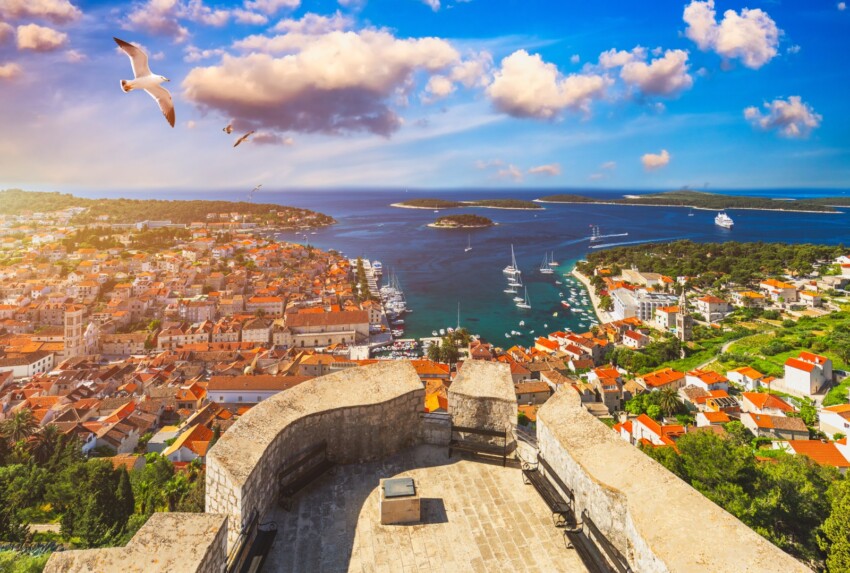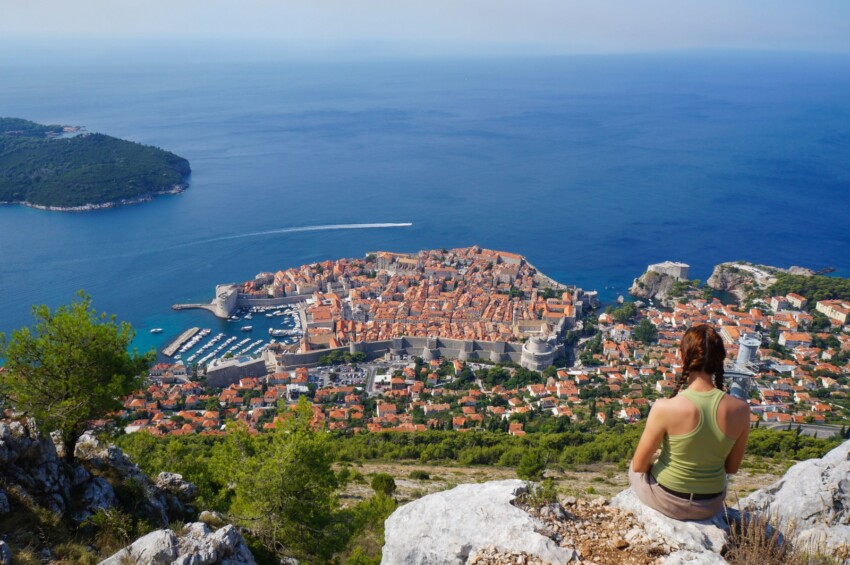

Croatia is the other side of the Adriatic Sea: a country that still has clear traces of a Roman and Venetian past, but has developed a strong identity culture, with its own traditions and artistic movements.
With hundreds of kilometres of coastline and a thousand islands, 50 of which are inhabited, along which lie enchanting beaches lapped by a transparent sea, Croatia was naturally destined to become a favourite destination for European tourists for their seaside holidays. Its tourist success, however, is not only due to the beauty of the landscape and the mild climate, but also to the good value of accommodation and services.
In addition to basking in the sun and cooling off with a dip in the sea, on a holiday in Croatia you can visit beautiful cities such as Dubrovnik, Split, Zadar, immerse yourself in the greenery of lush national parks, and try your hand at adrenaline-pumping activities such as rafting, canyoning, mountain biking, trekking and diving.
Zagreb, Croatia’s exciting capital city, is a bit of a world unto itself, far from the coast and tourist resorts, but it deserves to be included in your travel itinerary.
For the young, Croatia is also a lot of fun: some resorts are entirely devoted to nightlife, with beach parties and legendary electronic music festivals.

The best time to go to Croatia is from May to September, months when good temperatures allow you to enjoy the sea and outdoor activities.
July and August are the most expensive months and those with the greatest influx of tourists; it is better to go in May-June or September if possible: the beaches will be less crowded and the hotels less expensive. On the other hand, you will have better connections to the islands in the peak months.
Autumn is pleasant, perfect for those who want a holiday of cultural visits and trekking, but generally too cold for swimming in the sea.
Winter is ideal for those who want to visit Zagreb because many cultural events are organised during this period (don’t miss the Christmas markets!), but be sure to pack warm clothes: winter in Zagreb is very cold.
If you live nearby, the best way to get to Croatia is by car. You can also take a ferry to Croatia from several Italian cities like Ancona, Trieste, Venice or Bari.
From some of these ports there are also fast hydrofoils, suitable for those who are not interested in transporting a car but want to reach their destination in less time.
Another possibility is to reach Croatia by plane. There are low-cost flights to Zagreb, Dubrovnik, Split and Zadar.

There are around 50 inhabited islands in Croatia and all of them boast beautiful beaches washed by crystal-clear sea. There are many different ones, some more suited to young travellers looking for fun, others remote and isolated perfect for those who want peace, and still others easy to reach and full of amenities, suitable for families and those who like comfort.
If you don’t know which one to choose, go straight for the best: here are the five most beautiful islands in Croatia.
Hvar is known as the Croatian island with the most days of sunshine per year. It is a chic island with many luxury hotels and restaurants, perfect for those who love the high life. Those who don’t like to show off can escape to the more isolated beaches and enjoy the beauty of nature in peace.
Brac ‘s fame is linked to the beautiful beach of Zlatni Rat, a tongue of white pebbles that juts out into an incredibly azure sea. You may have already seen it in a thousand photos, but it absolutely must be seen in person.
Pag is an island with a dual soul, trendy and meditative. Its main attractions, beach clubs and electronic music festivals on the one hand and a barren lunar landscape on the other, attract and enthuse very different types of tourists.
Krk is a Croatian island that is very easy to reach. Due to its proximity and the quantity of tourist services, it is particularly suitable for those travelling with children.
Rab is the Croatian island recommended for those who love sandy beaches, easy access to the sea and calm waters. It is a true natural paradise, declared a Geopark in 2008.

Croatia is almost always thought of as just a beach holiday destination. In reality, in addition to kilometres and kilometres of beaches in this country you will find many places to visit, cities that are true architectural gems, with a rich historical and cultural heritage, and breathtaking natural landscapes.
Here are the must-see attractions in Croatia.
Rightly known as ‘the pearl of the Adriatic’, Dubrovnik is a sunny and refined city where man-made constructions coexist harmoniously with natural beauty.
The best way to appreciate Dubrovnik is to admire it from above, walking along the mighty walls that have defended it for seven centuries.
After this fascinating walk, descend into the heart of the old town for a stroll through streets, alleys and squares rich in history and art. During your walk, you can admire elegant Renaissance and Baroque palaces and beautiful churches.
Other attractions not to be missed in Dubrovnik are the impressive Lovrijenac fortress, perched on a promontory overlooking the sea, and the touching War Photo Limited museum.
Croatia’s second largest city and the heart of Dalmatia, Split is a lively city, perfect for a holiday combining cultural visits and beaches.
Its most famous attraction is the splendid Diocletian’s Palace, built in Roman times and modified in the Middle Ages. Don’t expect a single building, this is a true city within a city, where you can stroll, drink coffee and shop.
Visiting it from the inside, walking through all the narrow streets of the complex, is fun and stimulating; seeing the palace from the outside, admiring the contrast between the white colour of the stone and the blue of the sea, is truly enchanting.
One of the most beautiful nature excursions you can make in Croatia is to Plitvice National Park, an extraordinary natural scenery where water is the protagonist. Within an area rich in vegetation, rivers and streams flow into sixteen lakes, forming impressive waterfalls.
Inside the park you can take exciting walks in the middle of the water, walking on wooden footbridges that wind along the entire profile of the lakes. There are trails of varying lengths, suitable for both those who just want a relaxing walk and those who prefer a strenuous trek.
Zagreb is one of Europe’s most underrated tourist capitals. Don’t make the mistake of ignoring it either: it is an elegant city with a Central European charm reminiscent of Vienna and Bupadest, dynamic and lively. It is divided into an Upper Town (the historical centre) and a Lower Town (the modern area).
You can easily fill a whole weekend visiting Zagreb’s museums, parks, churches and monuments, and there will probably still be things left to see – a good excuse to return.
Of Zagreb’s many attractions, the most curious is the Museum of Broken Hearts, which exhibits objects voluntarily donated by people from all over the world related in some way to the end of a love affair.
Due to its location in northern Dalmatia, Zadar is an excellent base from which to explore the coast or nearby islands. For those who decide to stay, the city holds pleasant surprises in store, between masterpieces of the past and ingenious modern works.
Zadar’s two iconic monuments are the art installations Sea Organ and Sun Salutation, both by Croatian artist Nikola Bašić, which play with the elements of nature to create highly spectacular visual and sound effects.
The Croatian flag consists of three horizontal stripes of red, white and blue with the nation’s coat of arms in the centre, i.e. a red and white chequered shield surmounted by a crown of five coats of arms representing the region of Zagreb, Dubrovnik, Dalmatia, Istria, Slavonia. It has been in force since 1990.
Since 1 January 2023 Croatia has adopted the Euro, so it is no longer necessary to change money into the local currency: before 2023 the Croatian currency was the Kuna.